From the Field
February 20:
Rich Hoyer on his recent private tour to Baja California Sur
Extremely pleasant weather, plenty of great birds, and some emotionally intense wildlife encounters outlined the Baja California Sur section of the tour. Topping all was our second boat ride on Bahia Magdalena to witness the wintering Gray Whales. After being thoroughly delighted with our views of a shy female with her very young calf, we proceeded to encounter another mother who seemed to enjoy showing her week-old baby the delights of a boatful of humans. Over an hour spent with them seemed to pass in a moment, during which time some of us even got to stroke the baby when it surfaced right next to the boat. On another occasion we had the fortune of staying at a B & B by a beach and arriving there in time to watch the sunset release of about 130 baby Olive Ridley sea turtles, hatched during the day in an enclosure protected from predators.
The rest of our week was spent visiting a variety of habitats from mudflats to desert to oak woodlands where we saw a total of 173 species, about 70 of which were new for the trip, including the few endemics found in the Cape Region. The adorable California Quail delighted most of all, but it was close in votes to a stunning male Costa’s Hummingbird with his glittering, violet-flared gorget and crown. Other bird highlights were colorful Spotted Towhees in the mountains; a couple of Greater Roadrunners; a Western Screech-Owl sitting low in a bush—doing its best, but failing, to avoid being seen; a stake-out vagrant Scissor-tailed Flycatcher that had been a longshot, not having been seen in over two months; and cheeky Cactus Wrens, always charismatic with their complex colors and patterns and bold personalities.
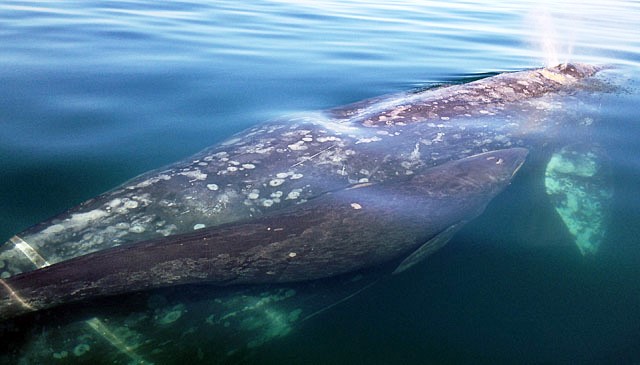
Gray Whales
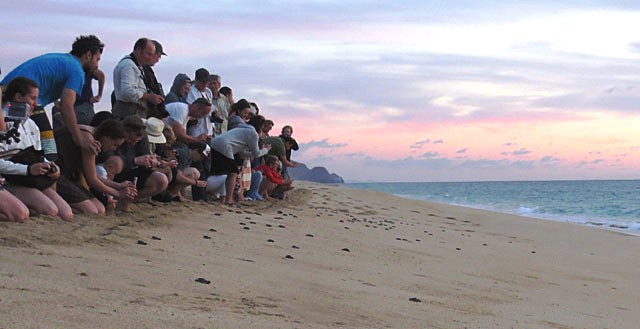
Olive Ridley sea turtles
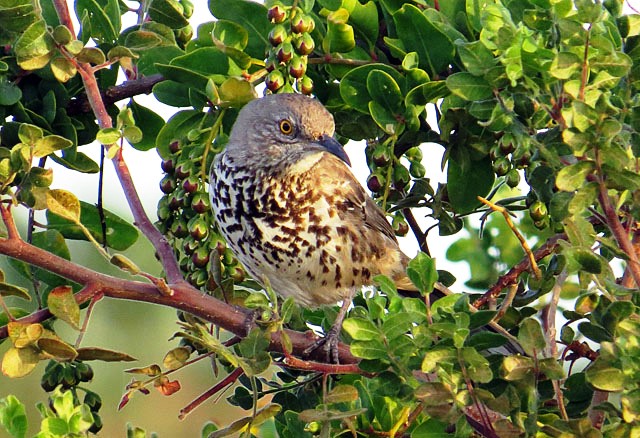
Gray Thrasher
February 18:
James Lidster on his recently concluded tour of Ghana
You might think, if you believe the news, that West Africa is a no-go area. Thankfully birders know better and once again we were treated to a couple of fantastic weeks birding in Ghana. The people are as friendly and welcoming as ever and the birds didn’t disappoint. The obvious highlight of this trip is always the Yellow-headed Picathartes, and now there is no need to sit for 2 uncomfortable hours on a rock to see it. This year, after a nice walk through a shaded forest and one slight uphill climb, we positioned ourselves on benches and waited for the bird to appear – which they did only 7 minutes later!
Interestingly, for the first time ever the Picathartes nearly got knocked off their 'bird of the trip' position by a Nkulengu Rail (below). This is actually the 2nd tour here we have seen it on, which is no mean feat when you consider that less than 100 people have seen the species… ever.
Elsewhere we visited the canopy walkway at Kakum and saw Rosy and Black Bee-eaters (below), Congo Serpent Eagle (below), and Long-tailed and Bat Hawks.
For the second year in a row we camped in Ankasa, where our walk-in tents with beds (below) were a welcome change from the terrible hotel we formerly had to use. The tent camp has working showers and washrooms with water, plus cold beer and cooked meals (all of the latter missing from the old hotel). A great way to end a day when you have seen White-bellied Kingfisher, African Finfoot, Hartlaub's Duck, Great Blue Turaco or White-crested Tiger Heron.
In the north we spent 3 nights at Mole where we saw African Elephants (below). The lodge’s ridgetop swimming pool provided the ideal way to cool off in the heat of the day after having seen Violet Turacos and White-throated Francolin (all below).
For a great selection of photos from the tour, check out tour participant Francesco Veronesis’s Flickr page.

Nkulengu Rail

Black Bee-eater
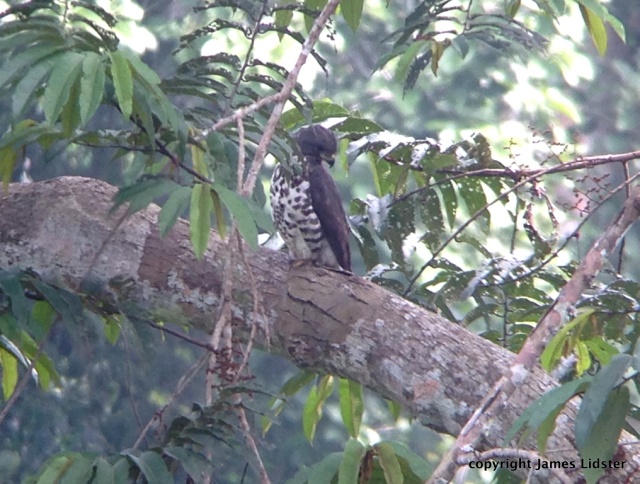
Congo Serpent Eagle
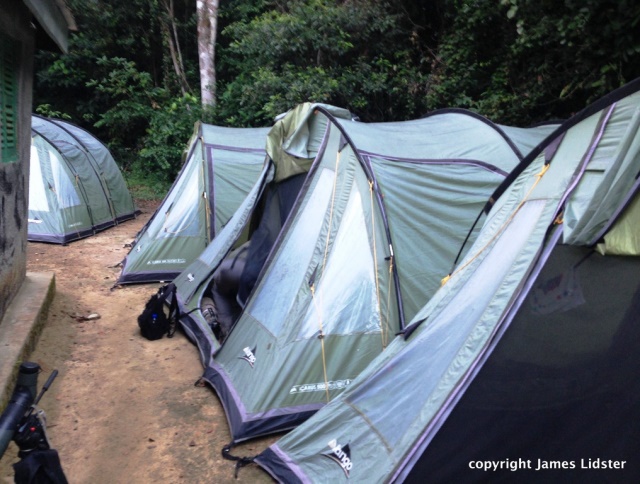
Ankasa tent camp
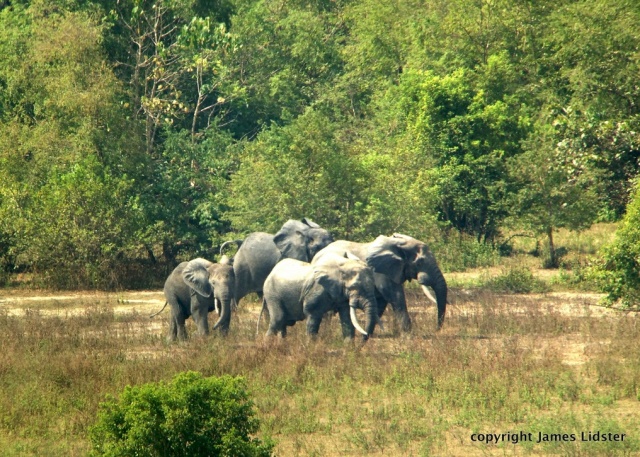
African Elephants
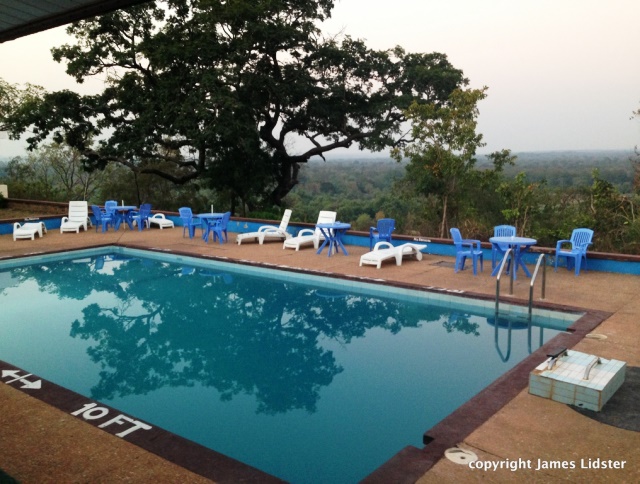
Ridgetop swimming pool in Mole... ahhh!
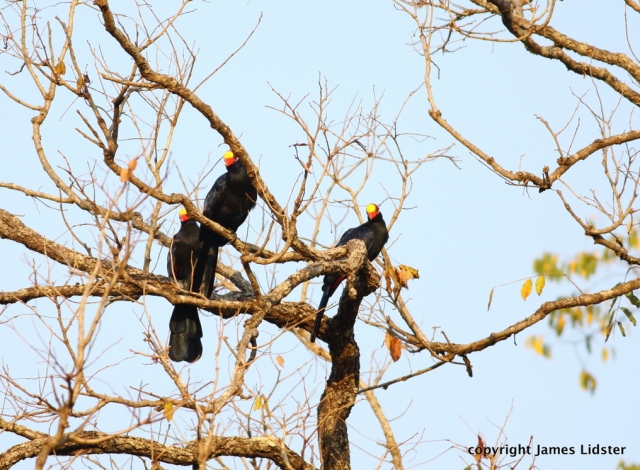
Violet Turacos
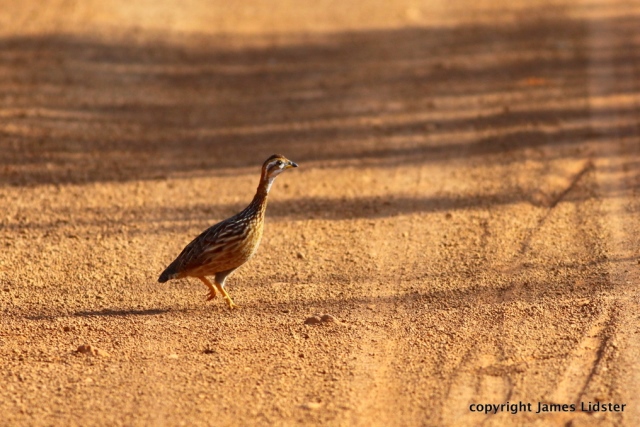
White-throated Francolin
February 13:
Fabrice Schmitt on his recently concluded tour to Guyana
The 2015 WINGS tour to Guyana was a great success! Even though this year was drier than average with extremely low water levels on the Rupununi savanna, we managed to see a stunning number of our “Guianan targets”, including excellent views of Guianan Cock-of-the-rock (below), Capuchinbird, Blood-colored Woodpecker (below), Rufous Crab-Hawk, Spotted Antpita, White-winged Potoo, White-bellied Piculet, Black Curassow, several groups of Grey-winged Trumpeter, Red-fan Parrot, and Todd’s Antwren (just to name a few).
Of course, our trip wasn’t solely focused on the regional specialties. We won’t soon forget our fantastic encounters with more widespread species, such as the Black Hawk-eagle perched on the roadside, two Pinnated Bittern in the reeds at Karanambu, the Great Jacamar at Surama, a Long-tailed Potoo on its day roost (below), several splendid Swallow-tailed Kites hunting insects in the canopy at Atta Lodge, an Ornate Hawk-eagle soaring just above the Essequibo River, and a stunning Agami Heron near Iwokrama River Lodge (below).
We also had fantastic sightings of other wildlife including repeated views of Giant River Otters, a Brazilian Tapir swimming in the Essequibo River (below), four species of Monkeys, and several species of amphibians and reptiles including a beautiful Yellow-bellied Rat Snake capturing a frog (also below).
Though Guyana is still far down the list of frequently-visited countries by tourists, more and more birders are coming here to experience the incredible wildlife and extensive untouched forests. The fact that we saw up to 12 different curassows in a single morning shows how wild and protected the forests of Guyana are.
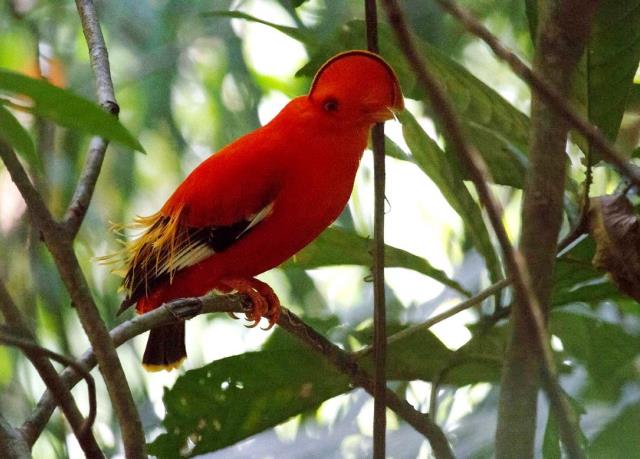
A beautiful male Guianan Cock-of-the-rock seen on his lek. photo: Karen Clarke
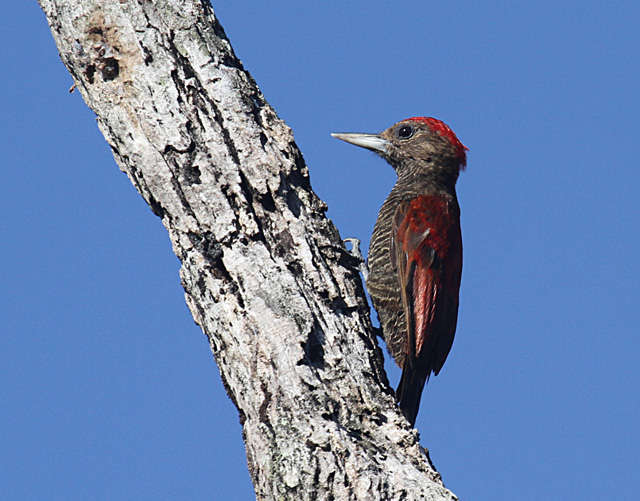
A striking male Blood-colored Woodpecker at the Georgetown Botanical Garden.
photo: Fabrice Schmitt
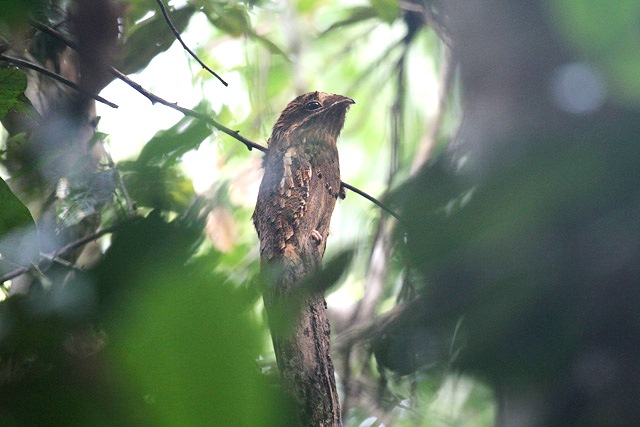
Long-tailed Potoo on a day roost. photo: Fabrice Schmitt
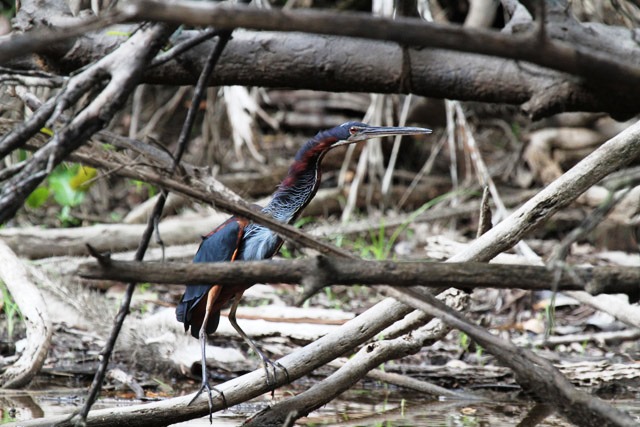
Agami Heron is arguably the most beautiful Heron in South America.
photo: Richard Greenhalgh
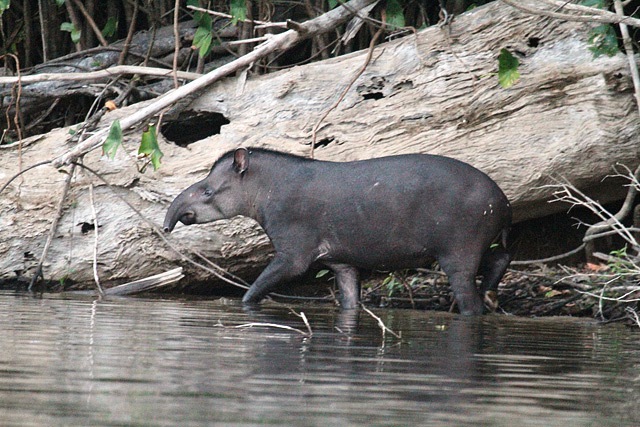
A Brazilian Tapir crossed the Essequibo river in front of our boats. photo: Fabrice Schmitt
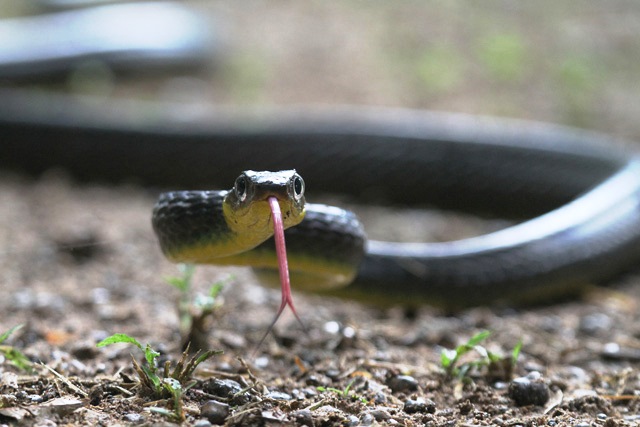
An attractive Yellow-bellied Rat Snake or Chironius multiventris. photo: Fabrice Schmitt

A happy group pleased by a wonderful trip!
February 12:
Jake Mohlmann on his just concluded tour, Arizona: A Winter Week in the Southeast
It was another wonderful week in the desert southwest as our Winter Week tour came to a close. Many highlight were had, including a meowing Black-capped Gnatcatcher in the foothills of the Santa Rita Mountains, the first of 3 gnatcatcher species seen during the week. We encountered 4 owl species, all during the day, including a placid Western Screech-owl (below), catching the first rays of light to warm its face from a nest hole. Several warbler species were seen, and the highlight was a Yellow-throated Warbler that decided to spend the winter in Patagonia … who wouldn’t!?
A fond memory for most birders who encounter a Canyon Wren (below), is always having the cascading song to remind them of the wonderful places they’ve been. We lucked out and had an emphatic male sing to us from 10 feet away!
The Sandhill Crane show in the Sulphur Springs Valley continued the tradition that this tour is known for: thousands of birds floating by in waves (below); but perhaps the highlight of the trip was a showy male Elegant Trogon (below), that sat for 20 minutes allowing everyone to get their souvenir shot of this southeast Arizona specialty.
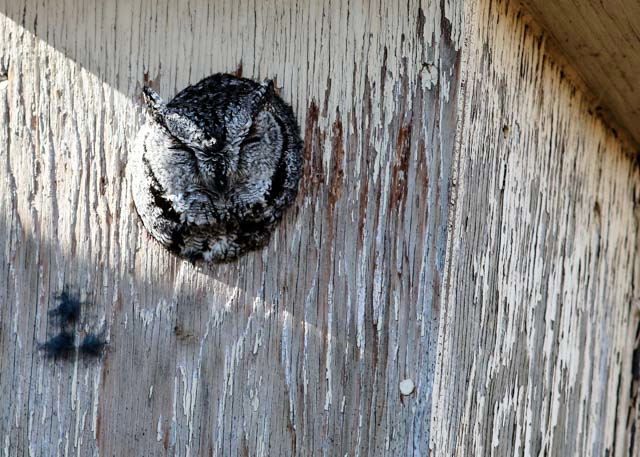
Western Screech-owl
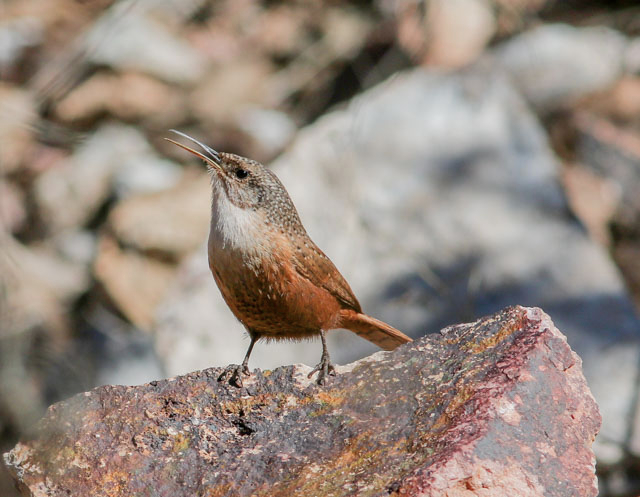
Canyon Wren
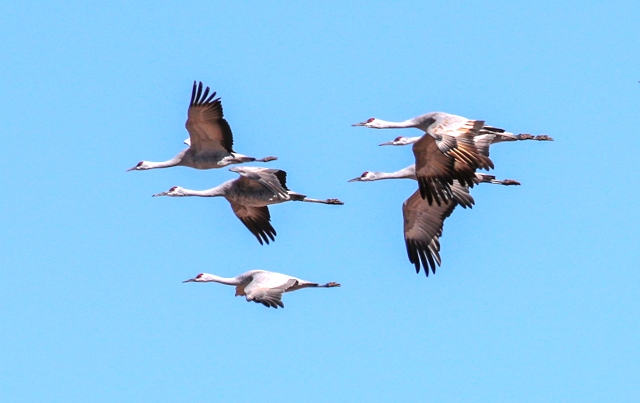
Sandhill Cranes
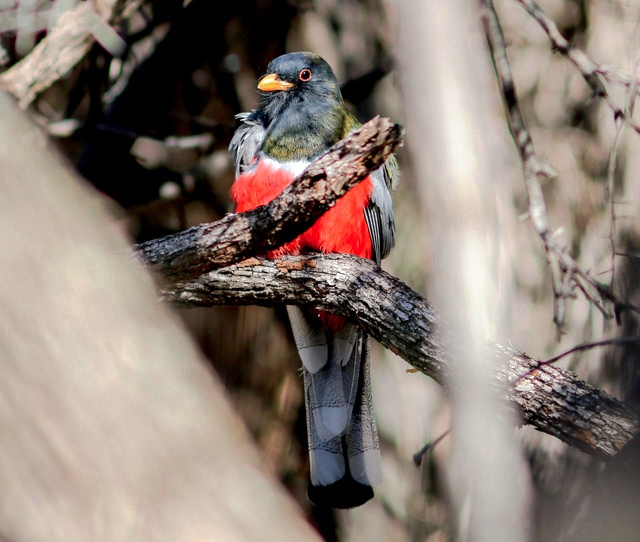
Elegant Trogon
February 8:
Jon Feenstra on his just concluded tour, Ecuador: A Week in Paradise
I just finished an always-exciting exploration of the best birding locations of northwest Ecuador, ranging from elfin woodland near treeline to hot lowland rainforest, with various degrees of cloud forest in between. All were easily reached in day trips from our base near Mindo. Highlights included nearly 40 species of hummingbirds including such luminaries as Giant and Sword-billed Hummingbirds, Velvet-purple Coronet, and the tiny Green Thorntail (which at some point on the trip landed on everyone). Tanagers were equally represented, some in exciting (and occasionally frustrating) mixed-species canopy flocks and other nonchalantly chowing on bananas at feeding stations. Some of our favorites were Bay-headed Tanager, Flame-faced Tanager, the local specialty Moss-backed Tanager, and the rare Blue-whiskered Tanager. There's more, of course: antpittas, flycatchers, toucans and parrots...so many birds.

The tiny Green Thorntail

Flame-faced Tanager
February 6:
James Lidster on his recently completed tour of Gambia
I recently completed my 12th tour to the Gambia and was once again blown away by the amazing birds and friendly people (now keener than ever to attract tourism). We use just two bases during our eight-day tour, with six nights at a comfortable hotel on the coast and a couple of nights upriver, where we take a relaxed boat trip through the mangroves.
Boating through the mangroves
The birds never disappoint with the expected rollers, bee-eaters, kingfishers, including African Pygmy, and sunbirds being complemented by scores of herons and egrets, owls including Verreaux's Eagle and African Wood, both Long-tailed and Standard-winged Nightjars and of course the star of the trip, Egyptian Plover.
Broad-billed Roller
African Pygmy Kingfisher
Long-tailed Nightjar
Egyptian Plover
Raptors are everywhere in the Gambia and it remains one of the easiest places in the world to see Beaudouin's Snake-eagle.
Beaudouin's Snake-eagle
With temperatures over 85 degrees on most days it is an ideal location to escape the cold winter weather, and sit by a water hole waiting for Orange-cheeked Waxbill, Red-cheeked Cordonbleu and Red-billed Firefinches to come and drink.
Orange-cheeked Waxbill and Red-billed Firefinch
Red-cheeked Cordonbleu
James will be returning to the Gambia in December 2015
February 5:
Chris Wood on his just completed Minnesota in Winter tour.
There is no tour that has a better ratio of "high quality" to total number of species than Minnesota in Winter, and our recent trip was among the best ever with Spruce, Ruffed and lekking Sharp-tailed Grouse; Black-backed Woodpecker; all the winter finches (including Pine Grosbeak, White-winged and Red Crossbills, and Evening Grosbeaks) and splendid ducks including 2 male Harlequins and a Pacific Common Eider. But owls stole the show, from a wonderful evening Great Gray to 11 Snowies in less than an hour including an adult male that we watched catch and quickly eat a vole). But this Northern Hawk Owl had the most votes for "Bird of the Trip”. It’s easy to see why.

A male Spruce Grouse picks up grit along a northern Minnesota roadside

A dusk Great Gray Owl

An adult male Snowy Owl

Voted bird of the trip, a brilliant Northern Hawk Owl.
February 3:
Steve Howell on his just completed tour to San Blas, Mexico
San Blas was ‘wonderful as usual.’ The great range of habitats, from mangrove boat rides and cool pine-oak forest to deserted beaches and shade-coffee plantations, produced over 250 fabulous bird species, and a very comfortable accommodation with great food and hospitality made for a most delightful week.

The many avian highlights included this confiding Colima Pygmy-Owl

A beautifully sunlit Mangrove Cuckoo,

Stunning Citreoline Trogons feeding in a fig tree right beside the highway,

And the very local Mexican Woodnymph.

As well as birds and other wildlife we enjoyed some stunning sunsets, this one on our last evening.
January 20:
Steve Howell on his just-completed private tour to San Blas and Colima
I just completed the first part of a private tour (the second part is ongoing with Rich Hoyer in Baja California). Great birding, warm weather, stunning scenery, good food, and, of course, friendly people everywhere, made this a wonderful trip with a great group of people.

We traveled from idyllic sandy beaches (where a Black-vented Shearwater fed among pelicans in the surf!

To the spectacular Volcanes de Colima, which offered countless photo ops…

As well as many great birds, including the stunning Red Warbler.

One highlight was a procession of mesmerizing murmurations of male Yellow-headed Blackbirds (estimated in total at over a million birds!), which held us spellbound for half an hour!

Among the many Mexican endemics, this Blue Mockingbird showed well.

And rarity of the trip went to this wintering Purple Sandpiper at San Blas (a long way from the cold North Atlantic!), here alongside a Surfbird.
January 7:
Rich Hoyer on his just-completed tour, Oaxaca at Christmastime
After not leading this tour for several years, it was great to be back in Oaxaca during this festive time. In many ways, it was like I never left. The delightful cultural goings-on, such as the Noche de Rábanos, the final night of the posadas, several ruins and markets, and the fabulous food in some of the city’s finest restaurants were memorable as always.
We had very full mornings and even some afternoons in the field where the birding was great fun. In the pine-oak forests we came across a very large and cooperative group of Dwarf Jays with a flock of Steller’s Jays and Gray-barred Wrens, but only after having frustratingly brief views of two shy pairs, but the ultra-cooperative Northern Pygmy-Owl was for some the day’s highlight. We returned to this forest habitat three other times, getting great views of Red Warblers, finding a fruiting tree full of six species of thrushes (including the elusive Aztec), and enjoying a picnic dinner that was followed by an attempt to see and hear owls. It didn’t seem too promising at first but ended with a fabulous finale of a handsome Fulvous Owl perched for a couple of minutes right over the road. Oaxaca Valley and foothill gems were Slaty Vireo, Oaxaca Sparrow, and Bridled Sparrow.
Our time on the moist northern slope and lowlands in the Valle Nacional and Tuxtepec region doubled our bird list. A cooperative Pale-billed Woodpecker, Yellow-tailed Oriole, and multiple kingfisher species were notable, but a true joy was watching a White-bellied Emerald bathing in the dew atop some giant elephant ear taro leaves in a swale below the road. We also saw quite a few lovely butterflies in this area, thanks to the tropical climate.
We ended the tour with a bunch of new species in the more desert-like habitats of the Oaxaca Valley, including three new and fabulous wrens – Rufous-naped, Boucard’s, and Happy, and finished our final day with a stop at the awesome hugeness of the ancient baldcypress of El Tule.

The always photogenic Bridled Sparrow never fails to elicit surprise from those who expect sparrows to be dull

Our picnic dinner in the forest ended with Mexican Whip-poor-wills, followed by a fabulous Fulvous Owl

A Northern Pygmy-Owl tooted above us and ignored the Olive Warblers and Hermit Warblers that came to mob it

The carved radish displays around the town square for the Noche de Rábanos occurs every December 23, and it was a highlight for many on the tour

This Glorious Blue-Skipper was the most colorful and most cooperative of the butterflies we saw near Tuxtepec








